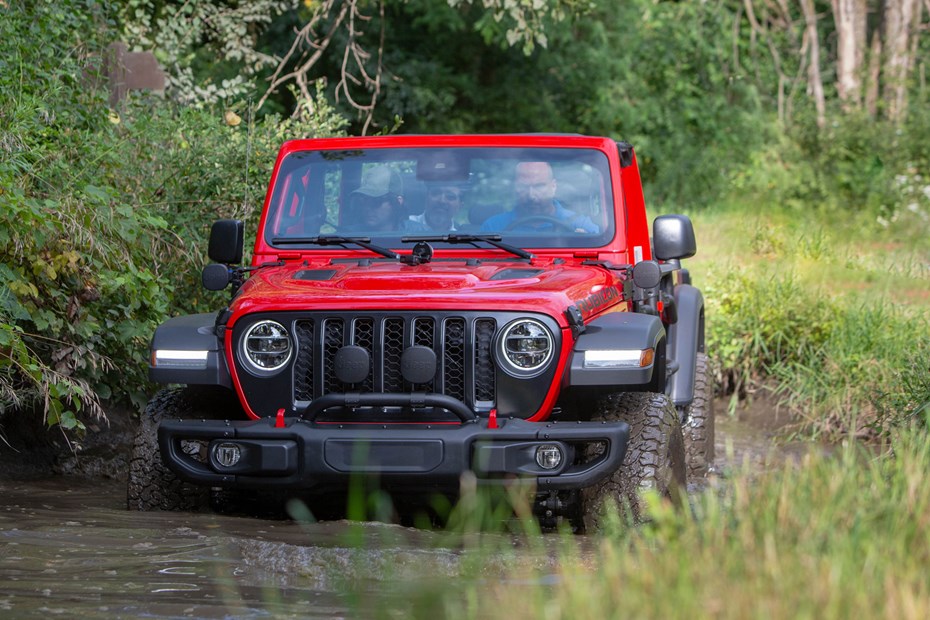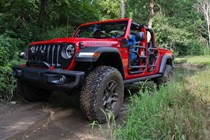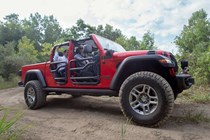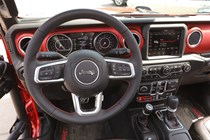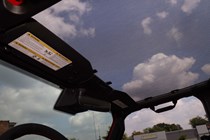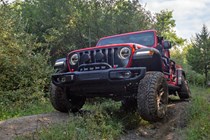Jeep has built a pickup. Called the Gladiator, it’s based on the Wrangler 4x4 and if you’re after a truck that can cope with some serious off-roading, you’re unlikely to find anything better than this.
As a working vehicle it has some issues – payload isn’t especially high, which has tax implications, and the load bed is much smaller than any rival double cab. But we’re confident the Gladiator will take you places no other pickup can go, and do so with a style that is unique to Jeep.
After all, can you think of another pickup that is designed to let you unbolt the roof and remove the doors?
So is the Gladiator an off-roader or a pickup?
The Jeep brand is best known for its off-road capability – and its most off-road capable model is the Wrangler. Starting with this as the basis for the Gladiator is a clear statement of intent, and reflects the kinds of buyers and uses Jeep expects it to find.
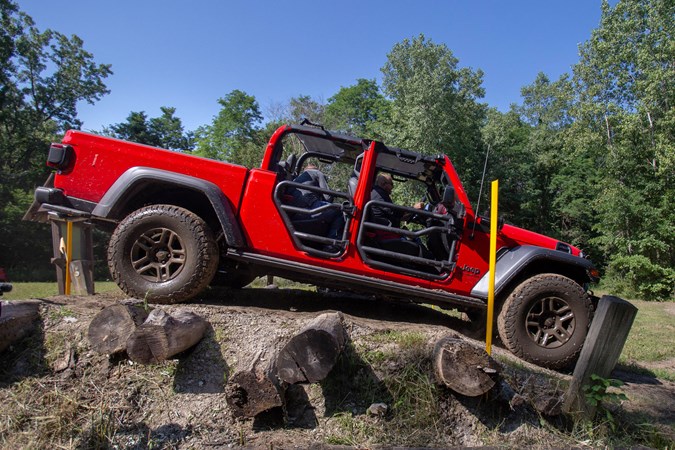
Like the Ford Ranger Raptor, this is first and foremost a lifestyle vehicle, although where the Raptor is built for off-road speed, the Gladiator is built for tenacity. It has an exceptionally accomplished four-wheel drive system and jaw-dropping levels of chassis articulation, enabling it to clamber over obstacles that would give pause to even the Arctic Trucks pickups available from some other manufacturers in the UK.
The purpose of this capability is to allow the Gladiator to get further into the wilderness in support of buyers’ outdoor pursuits (hunting and fishing being typical examples in the USA) while carrying more gear in the back than can be crammed into an equivalent Wrangler – though it would be equally adept at lugging tools and equipment to remote work sites.
What makes it so good off-road?
It’s tempting to simply say ‘because it’s a Jeep,’ but since every model goes through a rigorous development process there’s much more to it than that.
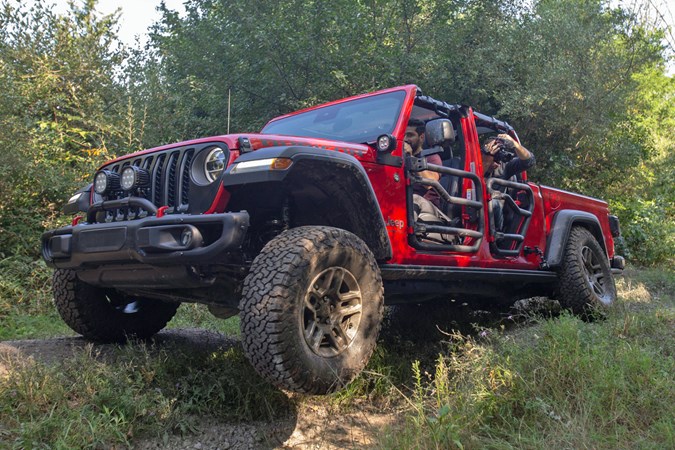
There are two different four-wheel drive systems, and though we were testing the range-topping Rubicon model with the more extreme Rock-Trak version, the entire Gladiator line-up including the Sport and Overland variants with Command-Trak 4WD gets Jeep’s ‘Trail Rated’ certification.
This is no mere badging exercise. Rather, being Trail Rated guarantees a level of off-road performance that’s intended to go way beyond the nerve of most casual greenlane enthusiasts.
In the Gladiator Rubicon’s case, the hardware that supports this includes a super low-range transfer case, front and rear locking differentials and an anti-roll bar in the suspension that you can disconnect (and reconnect) with the touch of a button in order to release even greater articulation angles.

You also get metal bumpers with removable end pieces and winch preparation, giving the Gladiator a crazy 43.6 degree approach angle – though the lengthened back end means the departure angle is limited to 26.0 degrees (the Wrangler’s is 37.0 degrees). Breakover angle is 20.3 degrees, ground clearance is 282mm, and it can ford water up to 762mm deep.
Other features include a choice of six-speed manual gearbox or the tested eight-speed automatic transmission – the auto’s manual mode including a special accelerator map in first gear for enhanced low-speed control – and a mechanical lever for the four-wheel drive, in a world where almost everything else now uses electronic switching.
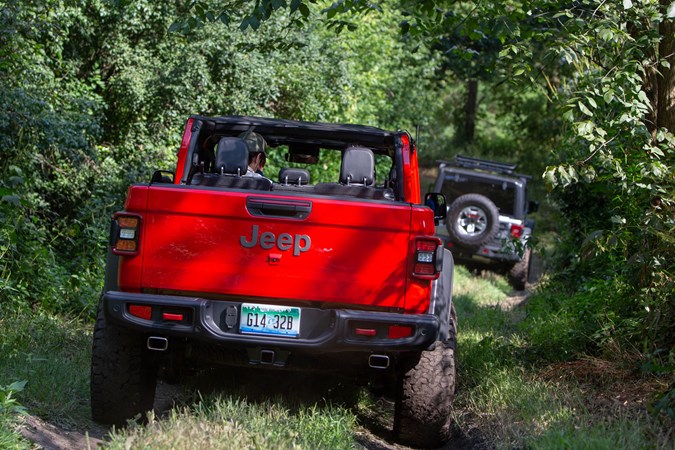
Compared with the Wrangler, the Gladiator has a longer backside and a longer wheelbase, plus bespoke five-link rear suspension. The extra inches mean it isn’t quite as nimble when crushing the countryside as its smaller sibling, but it’s still way more able than nearly anything else on the market.
But wait – the Gladiator in the pictures doesn’t exactly look like a standard vehicle…
You’re right, but only to the extent that it’s kitted out with some official Mopar optional accessories. Including the tube doors, which use factory latches and hinges, and are just about the best add-on we’ve sampled this year.
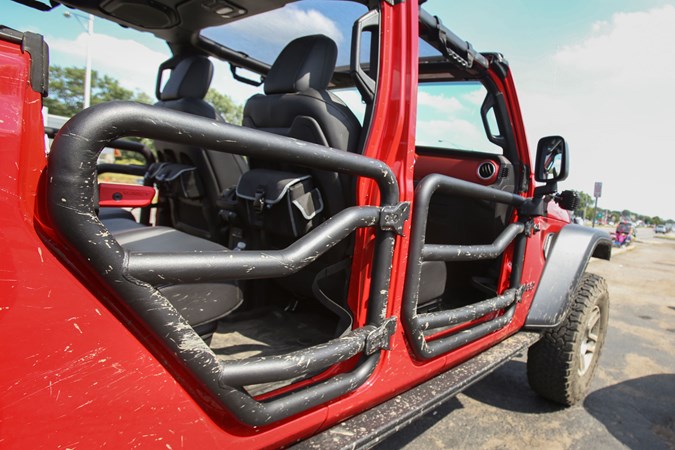
It’s only just about, because this Gladiator also has the Mopar 2.0-inch lift kit – which not only increases ground clearance and chassis articulation but also includes uprated Fox Racing shock absorbers and allows the fitment of 35-inch or 37-inch tyres, in this case wrapped around 17-inch Mopar slotted alloy wheels.
The removable roof (and the removable standard doors) are factory Gladiator equipment, as is a fold-flat windscreen and the exposed roll cage, which ensures the whole thing doesn’t turn to jelly with all those panels removed. Although the Gladiator is ‘body on frame’ construction like other pickups anyway, so would be pretty strong, regardless.
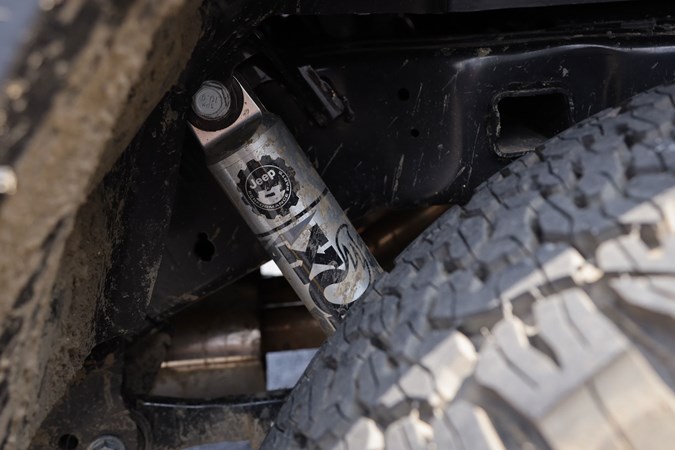
The mesh ‘bikini’ top, designed to the keep the sun and insects at least slightly at bay, is another Mopar part, as are the rubber floor mats (complete with drain holes so you can hose out the interior) and the array of ultra-bright LED auxiliary lights.
And Mopar does mean ultra bright; each of the small ones puts out nearly five times the illumination available from the headlights, while the larger one are eight times as bright. That’s enough power to melt the covers if you forget to take them off first.
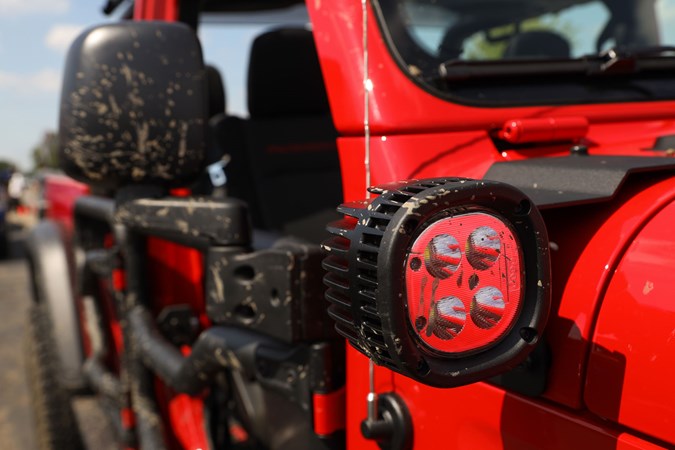
Icing the cake, so to speak, on this particular Gladiator is a cold air intake system (which can be combined with a snorkel if needs be) and a nicely tuned sports exhaust – which is quiet at a cruise but suitably menacing whenever you give the accelerator the boot.
Can you really hose out the interior?
Yep. Everything electronic and vulnerable is fully sealed – including the touchscreen infotainment system, which is supposedly capable of withstanding a pressure washer, should you need it to.
We were rather taken by the interior in general. This uses influences from a trio of historic Jeep models, and includes a few detailed nods to the 1941 original – Jeep’s design team loves a hidden feature and it will take you ages to find all the intricate touches.
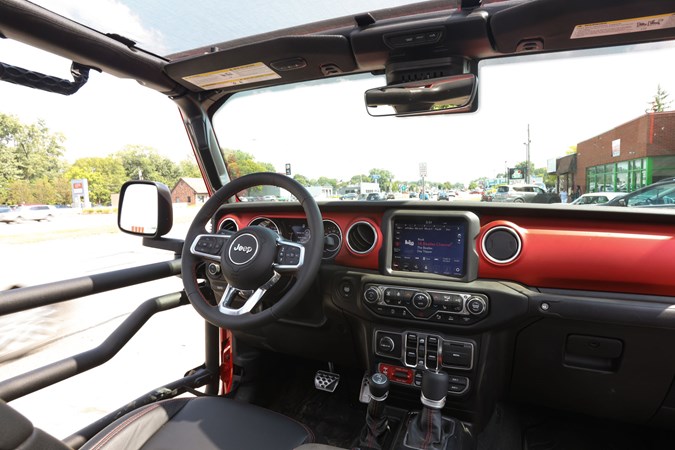
American cabins tend to be a bit cheap feeling to UK tastes, but everything in the Gladiator Rubicon seems fit for purpose, and we liked the bold use of colour across the dashboard – a new thing for Jeep with the latest ‘JL’ generation of Wrangler, introduced in 2018 – not to mention the red surround for the diff-locker switches.
The seats are comfortable and supportive, too, and there’s plenty of tech on this model, including a host of active safety features and a forward facing camera intended to make it easier to tackle some off-road obstacles. Not that you’ll have many visibility worries with the doors and roof taken off.
What’s the Jeep Gladiator like to drive?
Off-road, in this specification? It’s a dream. We tried it out at Jeep’s Chelsea Proving Ground in Michigan, and from the level of low-speed control to its sheer ability to swallow up obstacles and spit them back out, this is an incredibly well-engineered machine.

There are no fancy electronic terrain response systems here, so everything it does ultimately comes down to the driver. But a lifted Gladiator Rubicon isn’t likely to run out of talent before you do, and that’s before you’ve even bothered to activate the diff locks or disengaged the anti-roll bar.
With the low range transmission setting selected (probably the hardest thing you’ll actually do, as the mechanical lever won’t budge unless you’re rolling in neutral) it’ll creep forward at an treacle-like crawl riding a wave of torque that will carry you over – or through – many tricky hazards without requiring any input from you on the accelerator.
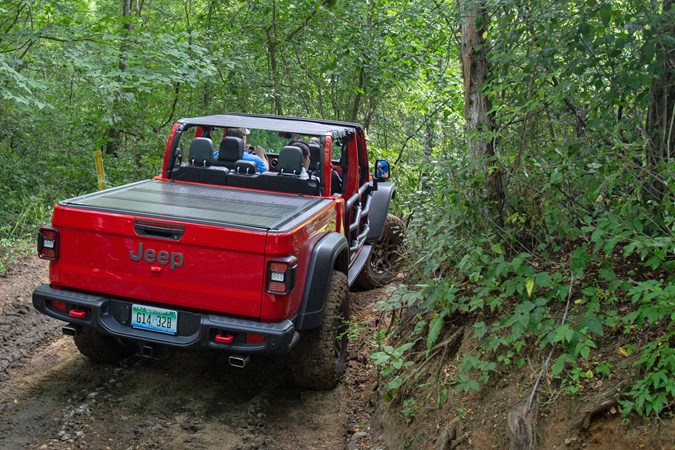
If you do need more muscle, special throttle mapping that’s automatically activated when you nudge the eight-speed auto into low-range first gear helps you access this super-smoothly, without any sudden flares of torque that might spin the wheels and cause the vehicle to slip.
All models are currently powered by a 3.6-litre petrol V6 with 285hp and 353Nm, providing plenty of performance and response for this kind of shenanigans. It sounds suitably fruity, too, thanks to that Mopar exhaust. A 3.0-litre V6 EcoDiesel is planned for 2020, offering 260hp and 599Nm.
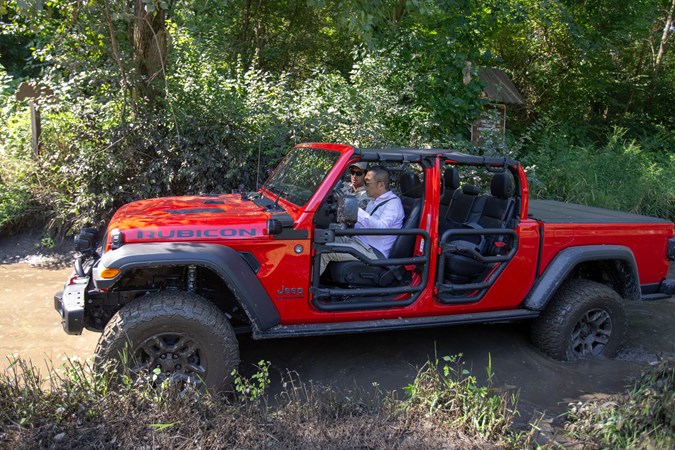
On the road, this Gladiator is perhaps not as well-mannered as a less modified example would be – the big tyres hum on the tarmac and dampen some of the steering response, the lifted suspension bucks a little over bumps and leans a long way in the corners.
But the sensation of having a breeze blow up your trouser legs through those tube-frame doors is a novel way to stay cool in Detroit’s summer sunshine, and passing strangers seem to warm to you instantly. ‘That looks fun!’ is a common shout – although perhaps the reception would be different on this side of the Atlantic.
How practical is it?
There’s plenty of space for people, front and rear, but versus a conventional double cab pickup the load capacity is limited.
The load bed is around 1,531mm long and 1,443mm wide with 1,138mm between the wheel arches. It’s also about 457mm deep, while the opening for the aluminium tailgate is 1,270mm. Aluminium is used for a number of other exterior components, which is good for keeping down weight, but could prove pricey to maintain, as it’s expensive to repair and dents relatively easily.
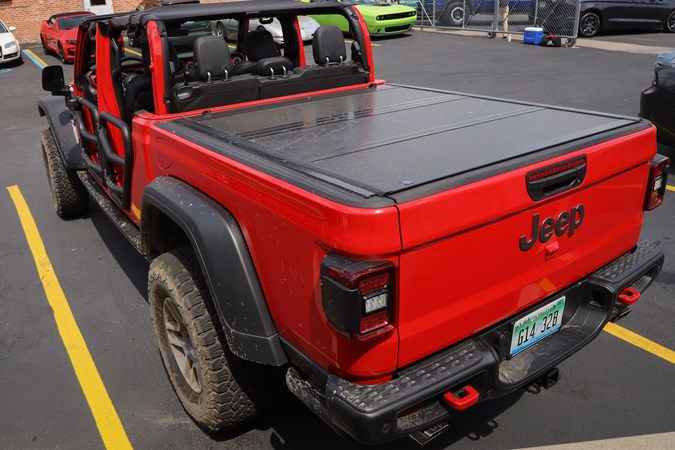
Payload is a greater issue, as the Gladiator is rated to carry just 725kg – some way short of the 1,000kg rating required to qualify as a light commercial vehicle in the UK, which in turn means it won’t qualify for fixed-rate LCV tax. Something that’s likely to prove expensive should it ever go on sale here.
On the plus side, it will tow up to 3.5 tonnes (3,500kg).
Can you buy a Jeep Gladiator in the UK?
Not at the moment – and although it is being produced in right-hand drive for other markets, there’s currently no firm decision about whether the Gladiator will ever be sold in the UK.
The Wrangler it’s based on is available, however, so there’s still hope that it might make an official appearance in due course.
US pricing starts at $33,545 (around £27,515 at current exchange rates) – with the Rubicon version tested here starting at $43,545 before options, which at around £35,720 looks like a bargain compared with the Ranger Raptor.
Tax and comparative costs mean it’s likely to be far more than that should it ever make it here, however. We hope this doesn’t dissuade Jeep from taking the risk, though, as this is a unique alternative to the usual lifestyle and off-roading choices.
Also read:
>> Ford Ranger Raptor review – high-performance off-road pickup driven
>> New pickups coming soon – and recent launch round-up
>> BMW X7 Pick-up concept – full details
Just so you know, we may receive a commission or other compensation from the links on this website - read why you should trust us.


